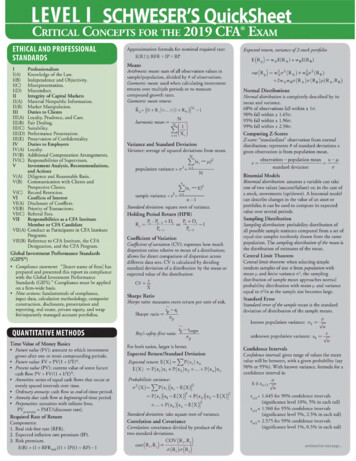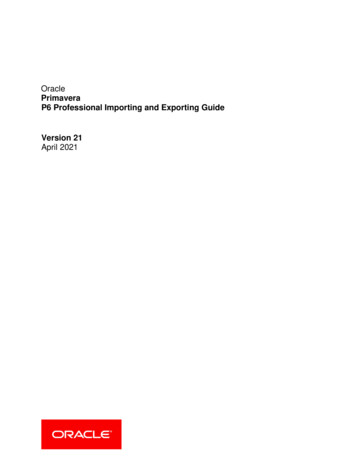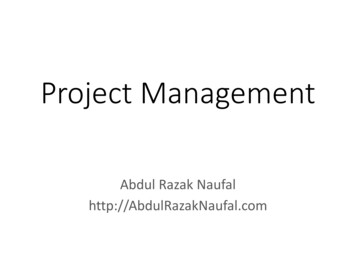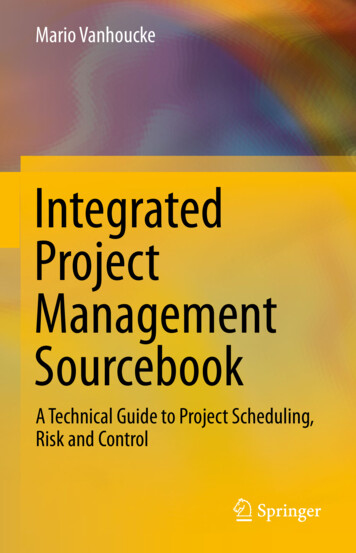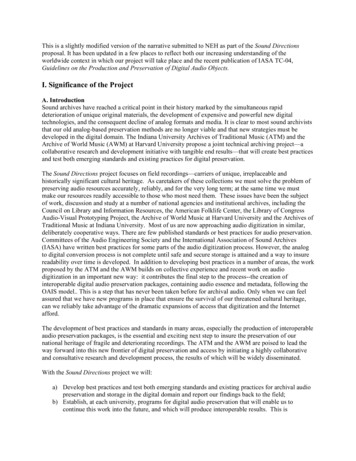
Transcription
This is a slightly modified version of the narrative submitted to NEH as part of the Sound Directionsproposal. It has been updated in a few places to reflect both our increasing understanding of theworldwide context in which our project will take place and the recent publication of IASA TC-04,Guidelines on the Production and Preservation of Digital Audio Objects.I. Significance of the ProjectA. IntroductionSound archives have reached a critical point in their history marked by the simultaneous rapiddeterioration of unique original materials, the development of expensive and powerful new digitaltechnologies, and the consequent decline of analog formats and media. It is clear to most sound archiviststhat our old analog-based preservation methods are no longer viable and that new strategies must bedeveloped in the digital domain. The Indiana University Archives of Traditional Music (ATM) and theArchive of World Music (AWM) at Harvard University propose a joint technical archiving project—acollaborative research and development initiative with tangible end results—that will create best practicesand test both emerging standards and existing practices for digital preservation.The Sound Directions project focuses on field recordings—carriers of unique, irreplaceable andhistorically significant cultural heritage. As caretakers of these collections we must solve the problem ofpreserving audio resources accurately, reliably, and for the very long term; at the same time we mustmake our resources readily accessible to those who most need them. These issues have been the subjectof work, discussion and study at a number of national agencies and institutional archives, including theCouncil on Library and Information Resources, the American Folklife Center, the Library of CongressAudio-Visual Prototyping Project, the Archive of World Music at Harvard University and the Archives ofTraditional Music at Indiana University. Most of us are now approaching audio digitization in similar,deliberately cooperative ways. There are few published standards or best practices for audio preservation.Committees of the Audio Engineering Society and the International Association of Sound Archives(IASA) have written best practices for some parts of the audio digitization process. However, the analogto digital conversion process is not complete until safe and secure storage is attained and a way to insurereadability over time is developed. In addition to developing best practices in a number of areas, the workproposed by the ATM and the AWM builds on collective experience and recent work on audiodigitization in an important new way: it contributes the final step to the process--the creation ofinteroperable digital audio preservation packages, containing audio essence and metadata, following theOAIS model. This is a step that has never been taken before for archival audio. Only when we can feelassured that we have new programs in place that ensure the survival of our threatened cultural heritage,can we reliably take advantage of the dramatic expansions of access that digitization and the Internetafford.The development of best practices and standards in many areas, especially the production of interoperableaudio preservation packages, is the essential and exciting next step to insure the preservation of ournational heritage of fragile and deteriorating recordings. The ATM and the AWM are poised to lead theway forward into this new frontier of digital preservation and access by initiating a highly collaborativeand consultative research and development process, the results of which will be widely disseminated.With the Sound Directions project we will:a) Develop best practices and test both emerging standards and existing practices for archival audiopreservation and storage in the digital domain and report our findings back to the field;b) Establish, at each university, programs for digital audio preservation that will enable us tocontinue this work into the future, and which will produce interoperable results. This is
groundbreaking work that is considered to be the next necessary step for true digital audiopreservation and access;c) In the process, preserve critically endangered, highly valuable, unique field recordings ofextraordinary national interest.While best practices have been and are being developed for the initial digitization process, they do notexist in many areas of the preservation chain. We will develop best practices by testing differentprocedures and techniques in selected areas including: specifications for master preservation files fromdifferent analog sources, management of digital files including names, announcements and embeddedmaterial identifiers, down-sampling and creating derivatives, ingestion and storage of digital audio objectsin digital library repositories, implementation of preservation services (including data integrity checking)for digital audio in digital library repositories, quality control and checking procedures, and theinterchange and reading of preservation files constructed using METS in an Archival InformationPackage (an AIP, following the Open Archival Information System model) between institutions. In eachof these areas, and others, we will report on procedures and techniques that produced the outcomes wewere seeking to the quality desired, as well as procedures that did not work within both the ATM andAWM preservation systems and workflows. This will be the most comprehensive and detaileddevelopment of best practices to date, covering many critical areas in the preservation chain. It will also,as noted above, be the first time that interoperability has been achieved for digital audio preservationpackages from two archival institutions. This will yield valuable data from two different operations andperspectives for use by other institutions designing audio preservation projects.B. InteroperabilitySimply put, if every institution’s buckets of bits are different in character they are idiosyncratic--notinteroperable--and true preservation has not occurred. Real preservation depends on the usability andreadability of files over an extended period of time. In addition, should one institution fail, this type ofinterchange guarantees preservation by enabling any engineer to access preserved content.Interoperable files depend on appropriate metadata to insure readability over time, and the developmentof best practices for the collection of metadata will be a critical part of this project. To digitize and store arecording so that it can be migrated and preserved, descriptive, administrative and technical metadata areessential in order to understand and interpret the digital object. Opaque digital objects are difficult if notimpossible to preserve. The development of compatible Submission Information Packages (SIPs), asproposed in this project, lays the groundwork for defining what constitutes a preservation object. Thestandards for the SIP already developed at Harvard offer a good place to start. Developing these standardsfurther at two different institutions is critical, and the process of submitting them to the scrutiny of otherprofessional engineers and digital library experts will enable further refinements. The lead engineer at theAWM, David Ackerman, has not only fostered the development of Harvard’s audio preservation efforts inthis area, but is guiding the creation of technical metadata standards for audio internationally by leadingthe Audio Engineering Society’s SC0306, the Working Group on Digital Library and Archive Systems.Further, Sound Directions will demonstrate that it is possible for different institutions to work within theirdiffering workflows and physical settings and still attain preservation through the production ofinteroperable results. Thus the information generated through this work will generalize to otherinstitutions who want to use the project’s innovations but cannot redesign their audio studios norcompletely alter their staffing situations in order to do so. Working together, the ATM at Indiana and theAWM at Harvard will develop methods and best practices that are largely system-independent, that canbe adopted by other institutions without overhauling their existing operations.One important byproduct of our project will be the creation by grant programmers of tools for technicalmetadata capture, workflow management, ingestion of preservation files and the dissemination of2
interchangeable preservation packages. These tools will be generalized and documented for release asopen-source software.C. Content and AccessThe recordings chosen as test cases for Sound Directions will be drawn from the rich, outstanding andunique ethnographic field collections of the Archives of Traditional Music at Indiana University and theArchive of World Music at Harvard University. A complete list of these materials appears in AppendixE. Field collections have been selected based on the following criteria: a) research and cultural value; b)preservation needs; and c) recording format (in order to test the transfer of a range of formats for thisresearch and development project.) At AWM, selected collections include historic field recordings fromEgypt, Iraq, Iran, Afghanistan, Pakistan and India, unique documents of cultural history from regions oftremendous interest to Americans today. At Indiana, selected collections include critically importantcultural materials such as music of Iraqi Jews in Israel, music from pre-Taliban Afghanistan, musicrelated to the world’s longest-running civil war in Sudan, and African-American protest songs from the1920s through the 1940s.Sound Directions is conceived in two phases, the first of which is the subject of this proposal. While thefocus of Phase 1 is research and development in areas critical to audio preservation, the project will alsoresult in the preservation of the above collections along with the creation of basic access to thesematerials. Phase 2 of the project, which will require a follow-on grant, will emphasize access. In Phase 2each institution will create on-line digital audio archives beginning with the collections selected for Phase1. The ATM will build the Cultures in Conflict Digital Archive (CCDA), creating on-line access to therecorded heritage of peoples around the world whose cultural practices have been threatened or abolishedas a result of conflict. The AWM at Harvard will create a digital archive using its rich historicalcollections of classical and folk music from Iran, Iraq, Pakistan and India. Both institutions will alsopursue a program of “digital repatriation,” making access copies available to nations and communitieswhose recordings we house. Critical preservation problems, however, must be solved before we can moveto providing this extended access.D. Why this Project Now?Recent years have brought forth significant public concern about the value of unique audio collectionsand the pressing need to reformat them to insure their survival. In the United States, the Council onLibrary and Information Resources (CLIR) wrote, in its proposal to survey audio collections that“collections of recorded sound are an irreplaceable record of the history and creativity of the twentiethcentury.”1 The proposal notes that “awareness that our audio heritage is in peril has reached the highestlevels of government, but the needs remain great.”2 Efforts to make progress addressing the probleminclude the summit-type meetings such as the federally funded conference Folk Heritage Collections inCrisis in December of 2000 ml, the Save Our Soundsproject at the Library of Congress that ensued http://www.loc.gov/folklife/sos/, the CLIR survey ofunique audio collections held in academic libraries http://www.clir.org/pubs/abstract/pub128abst.html andthe Sound Savings symposium at the University of Texas in 2003http://www.arl.org/preserv/sound savings proceedings/introduction.html. Numerous workshops flowingfrom these efforts were held at professional societies to address the inextricably linked issues ofpreservation and access to these recordings, making the point that there effectively is no access withoutpreservation. Indiana and Harvard have been integrally involved in these conversations.At this time, the International Association of Sound Archives, along with many sound archives around theworld, have come to the conclusion that long-term preservation of information contained on analog mediarequires transfer to the digital domain.3 Sweeping endeavors such as the Library of Congress’ AudioVisual Prototyping Project, and local ones including Harvard’s Music from the Archive project, Indiana’s3
Cultures in Conflict Digital Archive, as well as the Mellon-funded Indiana University/University ofMichigan digital archive of ethnographic video, are all proceeding along similar, mutually informed lines.What is needed at this time is for these leaders in the field to move forward with the knowledge we haveto develop more detailed and comprehensive best practices, test emerging standards and engage in theproduction of interoperable digital preservation packages.E. Sound Directions and Other Projects in the United StatesWe have researched a number of audio digitization projects and published recommended practices,looking for efforts similar to ours. Although we found no working projects that were as comprehensive ordetailed as what we are proposing, we did find three projects with which we share certain commonalitiesor to which we have looked for insight.1. Audio-Visual Prototyping Project at the Library of e.htmlThe audio preservation staff at the AWM has been keenly aware of the development of the Culpepperfacility at the Library of Congress. AWM has created preservation procedures that are in step with thisplanned facility. Carl Fleischhauer advised us initially4, and both David Ackerman and Robin Wendler(from AWM and the Harvard University Library Office for Information Systems) were then invited tooffer extensive comments on the metadata issues in the Culpepper plans. Sound Directions will make useof many ideas generated in the planning for Culpepper, instantiating them into an actual project whileextending them into the domain of interoperable files, an area that LC has not yet addressed.2. Digital Audio Archives Project at Johns Hopkins and Indiana UniversitiesFunded by IMLS, this collaboration between the Johns Hopkins University Libraries and the IU School ofMusic has undergone some changes and is still in the process of receiving institutional approval. It seeksto create a workflow management system prototype for digitizing audio, making use of simultaneousmultiple transfers and audio segmentation software. Project materials consist of open reel tapes of musicrecitals that were recorded in a consistent manner and are predictable in terms of their content andsequence. Given the wild diversity of archival field recordings on formats such as lacquer discs anddeteriorating open reel tapes, it is highly unlikely that ethnographic collections could make good use ofthis approach.3. George Massenburg Metadata ProjectWorking with colleagues in the commercial recording industry, George Massenburg is endeavoring topersuade production teams for recording labels to incorporate uniform metadata in their digital productsto insure readability of files into the future. Massenburg has indicated his interest in using the metadatastandards produced by David Ackerman’s Audio Engineering Society committee. Our project pairs nicelywith this work as, between the two, similar preservation procedures will extend from popular commercialrecordings through materials recorded in the field.Note that there are a number of projects as well as on-going work in other parts of the world,particularly Europe and Australia, that have developed preservation systems and established solidpractices for preserving audio in the digital domain. Some of this work is reflected in the new IASATechnical Committee document, IASA-TC04 Guidelines on the Production and Preservation ofDigital Audio Objects, while other parts remain unpublished.4
II. Background of ApplicantIn CLIR’s Folk Heritage Collections in Crisis, sound preservation consultant Elizabeth Cohen writes,“the development of successful preservation strategies will require the cooperation of computer scientists,data storage experts, data distribution experts, fieldworkers, librarians, and folklorists.”5 Indiana andHarvard bring together a powerful combination of leaders in all of the above fields. Our specialists are inconstant demand for consultations with other institutions. Each institution has preservation repositoriesbuilt on mass digital data storage systems and extensively developed digital library programs led byrecognized leaders in digital access and web delivery. Both Harvard and Indiana are charter members ofInternet2, which provides the advanced networking that will deliver high quality digital audio toclassrooms, conference rooms, and desktop computers around the world. Each institution features leadersin ethnographic fields including folklore, ethnomusicology and anthropology. We are well positioned toshare the results of our work widely. In short, given the particular resources available to us at ourinstitutions, and the extent to which we are actively engaged with other institutions and leaders in thesound archiving community, we are well positioned to take on this challenge.A. Indiana UniversityThe Archives of Traditional Music (ATM) http://www.indiana.edu/ libarchm/ is one of the largestuniversity-based ethnographic sound archives in the United States. Its holdings cover a wide range ofcultural and geographical areas, and include commercial and field recordings of vocal and instrumentalmusic, folktales, interviews, and oral history, as well as videotapes, photographs, and manuscripts. Forover fifty years, the ATM has been a recognized leader in the sound archiving community, developing instep with technological and theoretical advances in ethnographic research and recorded sound. Proof ofthe ATM’s leadership in this domain can be demonstrated through the numerous major grants it hasreceived over the years, from federal agencies such as NEH and private foundations such as Mellon. TheATM has ample experience both in preservation work and increasingly in digital audio projects. In the1980s, for example, the National Science Foundation funded the transfer of ATM’s famous cylindercollection onto 1/4” open reel tape. In more recent years, ATM has made several forays into digitization.One project, funded by NEH, resulted in the interactive CD-ROM publication Music and Culture of WestAfrica: The Straus Expedition (Gibson and Reed 2002). With funding from the Institute of Museum andLibrary Services and the Library Services and Technologies Act (LSTA), and in collaboration with IU’sDigital Library Program (DLP), ATM has created on-line access to Hoagy Carmichael oagy/. At present, ATM and DLP are completing anothercollaborative project in which they are creating the Starr-Gennett Digital Archive with LSTA funding.Recently, as ethnographic methods have begun increasingly to include video, the ATM has taken on thechallenges of video preservation and access through the EVIA Digital Archive project (EVIADA), a 1.3million project funded by the Mellon Foundation http://www.indiana.edu/ eviada/. This project, whichalso involves the DLP and participants from Harvard, has in many ways helped prepare IU for the SoundDirections project. In addition to further strengthening relationships and collaborative workflowsbetween ATM and DLP, the EVIADA project has helped ATM establish strong working relationshipswith IU’s mass storage system and has served as an initial test of the Fedora repository system.Finally, most pertinent to the present proposal is ATM’s Cultures in Conflict Digital Archive (CCDA)Pilot Project funded by IU’s Center for the Study of Global Change. The pilot project’s purpose was a) todevelop and test procedures and infrastructure for digital audio preservation and access; b) to generatedata on staff and resource needs, technical procedures, documentation procedures, work plan, transfer andprocessing time for various recording formats; and c) to clarify questions and needs to feed into thedevelopment of a full preservation system.5
ATM’s partner in this project, the IU Digital Library Program http://www.dlib.indiana.edu/, is dedicatedto the selection, production, and maintenance of a wide range of high quality networked resources forscholars and students at Indiana University and elsewhere, and supports digital library infrastructure forthe university. The DLP is a collaborative effort of the Indiana University Libraries, the Office of theVice President for Information Technology, the School of Library and Information Science, and theSchool of Informatics. The DLP’s current facilities include the Digital Media and Image Center(containing equipment for image, audio, and video capture), the Library Electronic Text ResourceService, and an extensive server infrastructure for support of digital projects, with life-cycle replacementfunding for hardware and software. DLP staff provide expertise in planning, creating and maintainingdigital projects. DLP’s Variations2 digital music library project http://variations2.indiana.edu/ received a 3 million grant from the National Science Foundation to create an integrated digital library that presentsusers with access to sound recordings, musical scores, and video in a variety of formats. DLP DirectorKristine Brancolini and Associate Director for Technology Jon Dunn have worked extensively with ATMstaff, also participating in meetings with Harvard staff in the planning of Sound Directions.The Massive Data Storage System http://storage.iu.edu/mdss.html is a distributed storage service offeredby Indiana University’s University Information Technology Services that is further described in theMethodology section below. This system consists of nearly 1.6 petabytes of disk and automated tapestorage with files mirrored between servers at both the IU Bloomington and Indianapolis campuses.B. Harvard UniversityThe Archive of World Music and its technological partner, Harvard College Library Audio PreservationServices, are both units of the Loeb Music Library (http://hcl.harvard.edu/loebmusic/) which, in turn, is acomponent of the Harvard College Library that serves the Faculty of Arts and Sciences at Harvard. TheArchive of World Music was established in 1976 and, with the appointment in 1992 of Kay KaufmanShelemay as Harvard’s first senior professor of ethnomusicology, the Archive moved to the MusicLibrary to become one of its special collections. It is devoted to the acquisition of archival fieldrecordings of musics world-wide as well as to commercial sound recordings, videos, and DVDs ofethnomusicological interest.The Archive quickly attracted major collections including the James Rubin Collection of Indian ClassicalMusic (probably the largest collection of Indian classical music in the U.S.), the Kay Kaufman ShelemayCollection of Ethiopic Musics, the Sema Vakf Collection of Turkish Classical Music (probably the largestoutside of Turkey), and the Laura Boulton Collection of Byzantine and Eastern Orthodox Chant.Collection development has focused primarily on the Middle East, Asia (broadly understood) and Africa.The Archive developed the Harvard College Library Audio Preservation Services (HCL APS), a state-ofthe-art facility managed by an internationally known engineer. Over the past five years HCL APS hasmoved toward joining its counterpart, the HCL DIG (Harvard College Library Digital Imaging Group) inproviding top quality service and advice for digitizing media. Both work closely with the HarvardUniversity Library Office for Information Systems on matters of building robust infrastructure andsustainable tools for creating and preserving digital objects via the Digital Repository Service.Substantial grant funding from The Laura Boulton Foundation, the Sema Vakf Foundation and theHarvard University Library Digital Initiative have provided funds for preservation and access to theAWM’s collections and for building substantial infrastructure to support long-term digital preservation.The AWM and HCL APS work in the context of an excellent overall preservation program centered in theWeissman Preservation Center (http://preserve.harvard.edu/hul/overview.html) directed by Jan MerrillOldham who recently won the 2004 Paul Banks & Carolyn Harris Preservation Award, given by theAssociation for Library Collections & Technical Services (ALCTS) in recognition of years of excellent6
leadership in preservation. Merrill-Oldham, with her high standards and vision, has served as a mentorand guide for the development of audio preservation at Harvard. Together we form a leading nationalpreservation program of recognized accomplishment.The Harvard University Office for Information Systems (http://hul.harvard.edu/ois/) coordinates all of theLibrary’s online catalogs (HOLLIS, its MARC catalog, OASIS for finding aids, VIA for visual images,and so forth) as well as the highly regarded Library Digital Initiative (LDI), the Digital RepositoryService, and innumerable tools that sustain and support online resources. Led by Dale Flecker and TraceyRobinson, OIS is home to nationally recognized experts such as Stephen Abrams and Robin Wendler,who will advise the current project. The Library Digital Initiative in some aspects parallels IU’s DigitalLibrary Program. Its mandate is to create the technical infrastructure to support the acquisition,organization, delivery, and archiving of digital library materials, provide experts to advise the communityon key issues in the digital environment and enrich the Harvard University Library collections with asignificant set of digital resources.The AWM and HCL APS have years of successful experience working with the Library Digital Initiativeand OIS. Together we have created significant infrastructure in support of audio preservation includingDmart, a tool for uploading audio files and attendant metadata into the Digital Repository, and an audioprocessing XML editor (APXE) for the efficient collection of audio metadata.III. Project HistoryA. OverviewThe Sound Directions project was born in March 2003 when Daniel Reed and Virginia Danielson wereserving on the Council on Library and Information Resources committee to create a survey tool foracademic libraries with audio collections. During a break, Reed and Danielson began discussing plans attheir respective archives, realized they were heading in similar directions and immediately saw thepotential advantages of collaboration. Points in common included: both were conducting digital-only pilot projects;both were convinced of the need to move toward digital preservation;both wanted to increase web access to collections;both had all the resources to accomplish the above—highly valuable, unique collections withcritical preservation needs; mass digital storage; exceptional personnel including national leaders incritically important areas (e.g., digital library staff, archival audio engineers).Over a year of planning has ensued, which included three face-to-face planning meetings between Reedand Danielson: at the Society for Ethnomusicology conference in Miami in October 2003, at Harvard inNovember 2003 (also involving Mike Casey and David Ackerman), and finally at Indiana University inMarch 2004 (involving librarian Sarah Adams of Harvard, David Ackerman, the entire staff of the ATM,and representatives of IU’s Digital Library Program, Variations 2 project, Massive Data Storage Service,and the EVIA Digital Archive). In these meetings, and through consistent phone and email dialog, thisproject began to crystallize. A critical point in the process was when we realized the extent to whichemerging standards remain untested in real projects, how little information is available in terms of bestpractices for digital audio preservation and the importance of producing interoperable files.B. Pilot ProjectsThe pilot projects that the ATM and the AWM have pursued have provided us with critical backgroundexperience and information that inform this proposal. ATM’s Cultures in Conflict Digital Archive(CCDA) Pilot Project was designed as a limited test run through digital preservation and access in the IUenvironment. Through this project, ATM made use of the resources presently at hand in order to clarify7
questions and needs that could be addressed in a fully realized, research and development project of thekind we are currently proposing. We evaluated every aspect of the process, from staff and equipmentneeds to IU’s digital infrastructure to work flow. The CCDA pilot project helped us identify whatemerging standards beg to be tested, and clarify in what areas we might pursue a more fully developedstudy of recommended best practices.The Archive of World Music’s pilot project, “Music from the Archive: A New Model of Access to Rareand Unique Sound Recordings,” received a grant of 204,000 from the University’s Library DigitalInitiative Program. Focused on three of the AWM’s premier collections, “Music from the Archive”integrated musical sound and related images in the same electronic research tool (see, for mes.html). The project developed technologies for access anddigital preservation of rare materials and it advanced ways of integrating digital access resources anddigital objects, providing a knowledge base that will inform the present project. “Music from theArchive” produced the tools that form the infrastructure of the AWM’s (and possibly the ATM’s) workon the
proposal. It has been updated in a few places to reflect both our increasing understanding of the worldwide context in which our project will take place and the recent publication of IASA TC-04, Guidelines on the Production and Preservation of Digital Audio Objects. I. Significance of the Project A. Introduction



